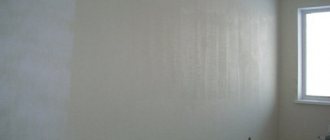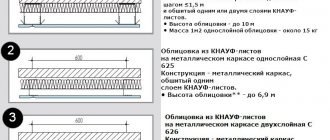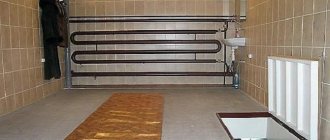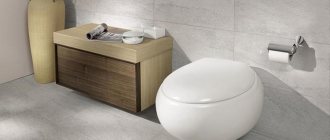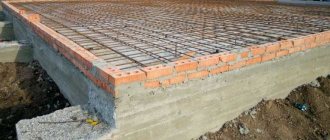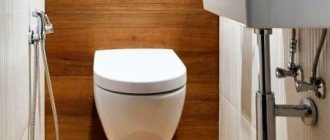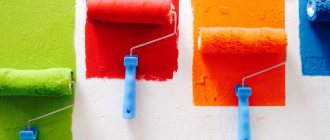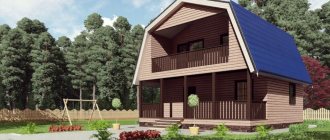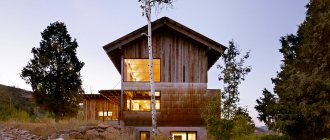When buying housing in a new building, people involuntarily begin to wonder whether it is necessary to level the walls in a panel house. Overall, if you want a high-quality finish, this can't be avoided. In new houses, especially budget ones with finishing, the cheapest materials are used, the quality of which is poor, so it is better to buy living space without finishing.
This way you can save money and choose the material yourself, which is environmentally friendly and possibly cheaper. If the surface of the wall is tiled, then it will not need to be leveled, but it will not be suitable for wallpaper at all.
Application
Very often, in new buildings, partition materials made from foam blocks, cinder blocks and bricks are used, less often from monolithic panels. If finishing is not provided, then it is necessary in any case; if it is not done, then leveling will affect:
- Removal of surface defects; seams, cracks, depressions and bulges in the wall will be completely covered.
- Leveling the plane so that the wall is perfectly flat and smooth, ready for finishing.
- Protection from external factors, the walls absorb all the moisture, as a result they gradually collapse, their strength characteristics decrease.
- Without finishing, the quality of the wallpaper will be at a low level; all the imperfections of the wall will be transferred to the relief of the canvas.
After leveling, the walls can be covered with any finishing coating.
Almost half of all residential buildings consist of monolithic panels, at first glance the plane of the walls is even.
But, as practice shows, to obtain first-class quality repairs, ideal wall alignment is not only necessary, but also necessary for:
- Increasing thermal insulation properties. The seams between the panels in a monolithic house shrink over time and begin to show through. In cold weather, heat loss increases several times.
- Increasing moisture protection and sound insulation, the more layers there are on the wall, the less noise from the street will pass through.
- Reducing the likelihood of fungus and mold appearing on the surface.
- To create a complete, durable layer of the wall surface, which eliminates the possibility of deformations, cracks and breaks.
- Opportunities to cover the wall surface with any decorative design (wallpaper, paint, panels, etc.)
If you decide to level the walls with plaster yourself in panel houses, you must follow the basic rules and procedure for performing the work step by step.
In general, the whole process is labor-intensive and precise, but almost anyone can handle this task. You should also understand that it would be more advisable to remove the previous layer of plaster.
Assembling the structure
The more complex the constructor, the harder it is to assemble it without a diagram. Even when assembling IKEA furniture, you need instructions, let alone combining two materials, two technologies, in fact, two houses in a single space. Of course, design must be approached extremely responsibly. The most problematic part of a combined house comes from its design feature, namely the connection of the first floor with the second.
The brick or concrete bottom is connected to the crowns of logs or beams of the upper floor using steel reinforcing bolts. In practice, however, the first crown, not secured by anything, is often laid on the floor slabs on top of the waterproofing. In any case, it is necessary to isolate the upper floor from the underlying part. When installing floors, vapor barrier and waterproofing films are used.
As a rule, difficulties arise at the docking points. For example, between the ceiling and the second floor, or between the first floor and the ceiling. We offer two flooring options - monolithic flooring and wooden flooring.
Surface preparation
The initial task is to remove the old layer of wallpaper or paint, plaster or whitewash. For rough cleaning, use a block of fine-grained sandpaper.
The removal process must be carried out in a circular motion until all excess layers are completely erased. After the final removal of all excess, the wall must be cleaned of dust and dirt. Next, the walls are primed; for this, a solution of soil is poured into a wide container or basin to wet the roller.
The priming process is mandatory; for better penetration and adhesion characteristics, it is recommended to apply two layers. If you miss this moment or do it poorly, then in the future this will lead to the peeling of the plaster layer from the monolith. As a result, additional financial costs.
When choosing a primer, manufacturers recommend purchasing concentrated solutions with enhanced binding characteristics, which are much cheaper than ready-made solutions. They should be diluted strictly according to the instructions in the appropriate proportions, otherwise it will not be possible to achieve the desired quality.
Interesting design ideas
When covering walls with panels, the design of the future coating also plays an important role. It should look beautiful, original, and complement the interior of the entire room. It is advisable to hide all communications and pipes. They can be neatly put away in the sheathing, but they will not disturb the overall appearance of the kitchen. If you plan to hide the wiring, then you should not wall it up tightly. You definitely need to provide access to it; to do this, you can make a small door in the plastic covering to access the wiring.
In addition, when decorating a kitchen space, it is worth remembering a few important tips:
- If the room is small, then you should choose light colors for the wall surface. A light tone will make the room even wider;
- It is not advisable to choose bright colors or large patterns. This style is best used for an apron;
- colors can be combined, but the main thing is that they match. It is better to first look at the photo with the methods of such design;
- The shade of the plastic base can be changed using self-adhesive film. How to do this can be seen in various photos.
Finishing the kitchen with plastic panels is an unusual option to decorate this room in a stylish, original way.
The main thing is to choose the right material so that it is durable, fire-resistant, and wear-resistant. In addition, it must fit into the overall style of the room and be in harmony with all pieces of furniture. Therefore, before you start working on decorating walls with plastic, it is better to look at photos with finishing options.
Selection of plaster
Before starting work, it is important to calculate the amount of mixture required based on consumption per 1 square meter.
m of wall 16 kg of ready-made mortar with a layer thickness of 2 cm. The thinner the application, the lower the consumption in the corresponding proportions. As a rule, this information is indicated on the packaging.
When plastering the walls of panel houses, it is more advisable to purchase special mixtures with plasticizers.
This application will allow you to achieve maximum application of the finished solution on the wall due to the inclusion of quartz sand in its composition. The surface will be as durable as possible, eliminating the possibility of damage to the plaster layer.
To work you will need tools:
- Spatulas of different widths are better than metal ones.
- A bucket for diluting the solution and storing excess putty. It is better to use a container with a volume of 15-20 liters.
- Drill with mixer attachment.
- Roller and thin brush for priming walls.
- Fine-grit sandpaper when preparing walls for gluing or painting.
- Rule, level and a clean rag.
Tools and materials for work
Before you level the walls in your apartment with your own hands, it is important to take care of the appropriate tools and materials. List of materials:
- beacons for leveling walls;
- paint brush;
- dry building mixture: putty for leveling walls, plaster;
- primer;
- container for preparation (bucket, basin);
- mesh for plastering walls (made of metal, plastic or fiberglass).
Tools:
- roller, large and small;
- a set of spatulas of different lengths;
- trowel, rule;
- tape measure, marker, level, plumb line;
- perforator;
- construction mixer;
- graters and other tools for stripping and sanding.
Now everything is ready and you can consider how to properly level the walls with plaster.
Wall alignment
Is it necessary to plaster the walls if deep cracks are visible after the primer layer dries? Of course not, it is important to fill them, it is better to use cement mortar, and when filling small cracks and irregularities, use putty.
After all the unevenness of the wall has been eliminated, it is necessary to re-prime its surface. Next, proceed to leveling. The first step is to install the beacons on the walls strictly according to the level. With a step between vertical axes of no more than 1 meter. Their installation begins from the corners of the walls.
Apply the solution with a narrow spatula
Then the tape is pulled between the control beacons in two parallel planes at a distance of 20 cm from the floor and ceiling. Next, the remaining beacons are placed along the rope and must be checked with a level. After the beacons have dried, you can begin leveling.
For better adhesion of the plaster layer, you should apply the prepared solution with a narrow spatula onto the surface of the panel wall between the beacons approximately 1 square meter wide. m. Then lightly smooth the mass with a wide spatula so that the solution is firmly fixed on the surface of the wall.
Next, using the trapezoidal rule, we smooth out the mass of spray with translational movements left and right, directing the rule upward. Excess plaster is removed from the rule with a narrow spatula into a bucket. In a similar way we level the remaining surface of the walls. For more information about alignment, watch this video:
To facilitate the alignment of corners, counter-shoulders are used, the installation of which must be strictly vertical.
When working with the rule, you cannot change the angle of inclination of the device. Otherwise, it will begin to sag, and the plane of the wall will deepen. You should not pay attention to minor irregularities and scratches; they can be eliminated with finishing putty. When working with gypsum plasters, it is important to use the ready-made solution before it begins to actually harden. If the mass begins to harden, it should be thrown away.
When plastering a bathroom, you should understand that it is not a room with a high level of humidity. Therefore, to level the surface, the same plaster is suitable as for the rest of the walls in the room. The ideal option for finishing a bathroom is to apply latex paint or tiles to the plaster.
Let's return to the question: “Is it necessary to plaster the walls in a panel house?” As it turned out, their alignment is still important; the appropriate material was selected for the interior decoration of street walls. However, when finishing partitions indoors, it is allowed to minimize the applied layer of plaster with a wide spatula to 1-2 mm without installing beacons.
The hassle with documents is left behind. You are now the owner of an apartment in a new building. Where to start repairs? Of course, from preparing surfaces for applying finishing coatings. Plastering in a new building is the basis for future repairs. All partitions and the ceiling need to be plastered. Is it necessary to do this? How to plaster walls in an apartment? What materials are best to use? Find out about it now.
Modern wallpaper for the bedroom: how to choose a wall covering
In 2021, the most interesting and in demand finishing materials will be:
- Photo wallpaper with exotic flowers;
- Fabric cotton wallpaper;
- Wood veneer.
When choosing a color scheme when decorating a room, it is necessary to take into account the location of the bedroom relative to the cardinal points. If the bedroom has a lot of natural light, then cool colors can be used to decorate it. In this case, mint, purple, and blue colors are ideal. If there is not enough natural light in the room, then you need to use warm shades of wallpaper to decorate the bedroom. The ideal option would be calm green, beige-coffee, yellow. The walls can be decorated with wallpaper made from natural materials, which will help give the room a more sophisticated and unique look. In addition, it is quite possible to use ones that are very simply glued to the wall, and at the same time it is possible to create a unique velor effect.
When decorating a bedroom 2021, you should use a minimum amount of decor so that the space of the room remains free, bright and filled with air. When choosing furniture, you should pay attention to modular furniture, which takes up very little free space, so it is possible to unload the space of the room, make it comfortable, practical and stylish.
Options for leveling walls in a new building
When thinking about whether you need to plaster the walls in a new building, remember that there are several ways to level the surface. For this, different materials and technologies are used:
- Plaster. During the leveling process, gypsum (for dry rooms), cement (for wet rooms) or polymer mixtures (universal option) are used. The advantage of this method is maximum preservation of volume, a healthy microclimate and protection of the internal space from moisture. The technique allows you to level out large differences in heights and hide significant defects in new buildings.
- Putty. It is used in cases where the walls are fairly smooth and there are no large potholes on them. Construction stores sell ready-made putty mixtures. The application process is so simple that anyone can handle it. This is the main advantage of the technique. In cases with large differences, the method cannot be used.
- Drywall. Frameless alignment involves the use of adhesive solutions. The method is used in large rooms where the issue of maintaining volume is not critical. The method is quite labor intensive. For a novice repairman, a problem may be the need to carefully seal the joints between sheets and places of fastening with dowels. High cost is also a disadvantage of the technology.
Types of plasters for new buildings
Manufacturers offer different compositions for plastering walls and ceilings in new buildings. Each material has its own advantages. By type of protection they are divided into the following:
- waterproofing mixtures are prepared on the basis of a binder component (cement) with mineral and polymer additives;
- soundproofing plaster is used for finishing industrial premises and contains sound-absorbing inclusions (expanded clay, slag, pumice);
- the heat-insulating mixture, in addition to cement, contains lime or gypsum, which increase the heat-insulating properties of the material;
- universal plaster, in addition to cement, sound-absorbing, waterproofing and heat-insulating components, contains additives that increase adhesion to the brick base.
The choice of composition depends on the purpose of the room. Each type of mixture provides reliable protection against one or more exposure factors. Choose a composition depending on which of them is a priority for protection.
Pay attention to "companions"
You, of course, can independently select and combine different types of wallpaper. However, if for some reason you cannot do this, you have nothing to worry about, because modern manufacturers offer their customers pre-designed combinations of various shades, textures, and other things. Such wallpaper pairs are also called companions. Wallpaper sets often include two types of coverage, made in the same color scheme, but differing in pattern, design and texture. Manufacturers of wall coverings offer a wide range of companions, among which there are sure to be those that you like.
Mixtures for plastering new buildings
Solutions are prepared based on different materials. All plasters can be roughly divided into three groups.
- Plaster. Environmental friendliness and lack of shrinkage are the main advantages of gypsum plaster. The low specific gravity of the layer reduces the overall load on the wall and increases its service life. The plasticity of the plaster makes it possible not to use a reinforcing mesh. Gypsum plaster has increased heat and sound insulation. To use such material, no special skills are required.
- Cement. The mixtures are highly durable. After application and hardening, the layer of sand-cement plaster cannot be destroyed without special tools. Durability is one of the main advantages of the composition. Excellent adhesion allows you not to use a special primer to increase the degree of adhesion to the base. Due to their high resistance to moisture, cement plasters can be used in damp areas.
- Polymer. This group includes plasters based on acrylic, silicone, silicate or siloxane. Along with improved protective qualities, they also have decorative value.
If you compare the costs of each type, you can see that cement mixtures are the cheapest. The gypsum mixture costs 1.5-2 times more than them. Polymer compositions are several times more expensive than those prepared on the basis of gypsum.
Rice. 2. Gypsum, cement and polymer plaster mixtures
Plastering brick walls
For plastering brick surfaces in a new building, a cement-sand, lime or gypsum mixture is suitable. It should be taken into account that CPS is much stronger than gypsum or lime plaster.
Before applying the composition, you need to prepare the wall. To do this, the masonry is cleaned of dust and dirt. Work in a new building is made easier by the fact that there is no need to dismantle the coating that was previously applied to the wall.
The cleaned surface must be primed. This ensures adhesion of the base to the material. For bricks with high porosity, a mineral-based primer is used. Dense bricks are primed with a composition with increased adhesion.
Decorating a kitchen apron
The apron in the kitchen is an important area that gives the main style to this room. First of all, it must be practical and fit into the overall interior of the entire room. In addition, it should be harmoniously combined with all pieces of furniture and complement their style. Be sure to look at the photo with apron design options.
When decorating an apron with plastic material, it is worth considering important features:
- it is important that it protects the wall surface from dirt, dust, splashes of oil, and water;
- Since in this area you often have to cook, fry, and work with water, it is worth choosing a material with high strength. It must also withstand exposure to detergents;
- To decorate your apron, you can choose an unusual design, for example, a base with flowers, kitchen attributes, fruits or vegetables. The main thing is that its overall appearance fits into the interior style of the entire room.
Plastering concrete walls
Load-bearing walls in new buildings, built using a monolithic method, are made of reinforced concrete. Reinforcement is inserted into the formwork. The gaps are filled with concrete mass. This method is being used more and more often in construction. The disadvantage of this technique is that the walls are quite crooked. Plastering concrete surfaces requires special skills and the use of professional equipment.
As part of the preparatory work, the wall is cleared of formwork grease. Large piles of concrete need to be cut down. Subsequent priming is designed to increase the roughness of the wall and protect it from mold formation.
The layer may be uneven. In some places it can be thick (up to 2 cm). Installing a mesh will protect the plaster layer from cracking. Most often, sand-cement mixtures are used in selected proportions.
Recommendations for plastering different rooms
When choosing a composition for premises in a new building, you need to listen to the manufacturers’ recommendations regarding protective properties.
- Kitchen, bath and toilet. Cement plasters are used to plaster walls in the wettest areas of a new building. They do not allow moisture to pass through and are strong enough to withstand ceramic tiles. The plaster in the bathroom must withstand prolonged exposure to steam and create an obstacle to the formation of mold. She should not be afraid of frequent temperature changes.
- Living rooms. The main selection criteria for the rooms in which we spend most of the day and sleep are environmental friendliness and the ability to allow air to pass through. Therefore, gypsum mixtures are used here. They perfectly prepare the walls of a new building for wallpapering or painting. The plasticity of the material makes it possible to plaster partitions of complex shapes, multi-tiered ceilings and niches before painting.
- Balconies and loggias. Increased protection capabilities are used in areas that are subject to temperature changes. Plaster with enhanced thermal and noise protection is what is suitable for a small space of a glazed loggia or balcony. These surfaces do not require finishing, which reduces the cost of repair work.
Unique wallpaper for the bedroom in a modern style
The bedroom is a completely separate room in the house, where each person can relax and unwind after a hard day at work. In order for your rest to be comfortable and your sleep to be complete, you need to properly decorate your bedroom using modern, high-quality finishing materials.
The bedroom space should be:
- Comfortable;
- Cozy;
- Simple.
A bedroom designed in a modern style looks very impressive. When arranging a bedroom, you need to unload the free space as much as possible and get rid of existing irritants. When choosing materials for wall decoration, you need to give preference to natural materials that will look unique and very neat.
When applying wall coverings, you must first carefully level the walls, and then stick wallpaper to be painted onto the leveled wall covering. Ordinary wallpaper with a slightly noticeable velvet structure looks very impressive. To highlight an accent wall located at the head of the bed, you can use decorative stone or wood for finishing. Preference should be given to naturalness.
Manual or mechanized plastering
There are two methods of applying plaster to the wall in a new building. The manual method involves applying the composition layer-by-layer manually using a spatula. This is a very labor-intensive and time-consuming method. To make the surface look perfect, you will have to spend more than one hour. If this is your first time using a spatula, the result may be very different from what you expect to see.
The mechanized method of plastering walls involves the use of special equipment. The plastering station mixes the solution and delivers it under pressure into the pipe. The operator only directs the flow to a section of the wall and monitors the uniformity of application. Then all that remains is to level the plaster layer using a long rule. This technology allows you to work with mixtures of different compositions and significantly saves time. In a couple of hours, one specialist can plaster an area of up to one hundred square meters. In this case, the quality of the layer will be much higher than with manual plastering.
Photo gallery
Contrasting combination of wallpaper in the bedroom Plain and patterned wallpaper in the bedroom
Each of us has our own idea of what an ideal bedroom interior might look like. This topic becomes relevant when you are planning renovations in your home. You can ask your friends for advice, but the answers you get will be too vague, numerous and different. In addition, most of the advisers probably do not have design knowledge. Meanwhile, you need to develop a bedroom interior design based on the opinions of experienced specialists. Thanks to their recommendations, you will create a unique and very cozy atmosphere in your bedroom.
When designing a room, we use a variety of techniques and materials to bring your ideas to life. The choice of wall and ceiling coverings plays an important role.
If you want to make a room both stylish and cozy at the same time, then the best option would be to use two types of wallpaper.
Modern designers have developed many options for wall decor in bedrooms with different combinations of several types of wall covering materials. You can decorate the walls of your bedroom using various types of plasters or paint them, however, using wallpaper is a much more economically driven decision. In addition, the fact that they represent the most environmentally friendly option among other finishing materials also plays in their favor.
In addition, the use of wallpaper opens up the widest design possibilities for you.
Among the common types of wallpaper, special attention deserves:
- Vinyl.
- Textile.
- Paper.
- Liquid or textured.
- Non-woven.
- Wallpaper made from materials of natural origin, including bamboo and bark.
All of the above types have specific features and are slightly different in operation. Designers offer us various options on how to combine and glue wallpaper. All you have to do is review this information and decide what suits you best.
Cost of different methods of plastering in a new building
The use of machine technology is justified not only by saving time. By choosing a mechanized method of plastering a house, you save on the labor costs of several plasterers. At the same time, the speed of work increases by 4-5 times.
The mechanized technique allows you to reduce the consumption of materials for plastering in a new building. And their cost for machine plastering is lower than their analogues for manual application. The quality of work is higher due to the fact that:
- the mixture is supplied to the wall under pressure;
- the solution used is more homogeneous;
- errors in preparing the mixture are eliminated, since its mixing is programmed and controlled by the processor.
A comparison of the cost of plastering walls for wallpaper or painting indicates in favor of the mechanical method. Manual application of one square meter costs 550 rubles. Carrying out similar work using a plastering station costs 220 rubles. The benefit is obvious.
